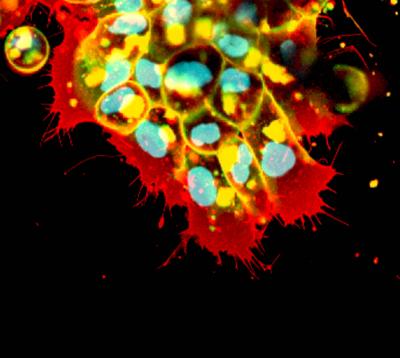Blocking cells' movement to stop the spread of cancer

In this image, the cells are stained red for cell protrusion, yellow for cell membrane and blue for nucleus. Credit: Prof. R. Mayor
Scientists discovered that cells can change into an invasive, liquid-like state to readily navigate the narrow channels in our body. This transformation is triggered by chemical signals, which could be blocked in order to stop cancer cells from spreading.
Most cancer deaths are not due to primary tumours, but to secondary tumours in vital organs, such as the lungs or brain, caused by cells moving from the original tumour to other places in the body.
The study led by UCL researchers and published today in the Journal of Cell Biology, used embryonic cells to investigate how groups of cells move in a developmental process similar to that used by cancer to spread around the body.
The team report a molecule called lysophosphatidic acid (LPA) changes cells from a solid-like to a liquid-like state, allowing cells to flow between normal tissues in the body. Scientists were able to switch off the signals from LPA, stopping the cells from moving down narrow, blood vessel-like channels.
Lead scientist Professor Roberto Mayor (UCL Cell & Developmental Biology), said: “We have found a way to stop the movement of embryonic cells by blocking LPA signals. It is likely that a similar mechanism operates during cancer invasion, which suggests a promising alternative in which cancer treatments might work in the future, if therapies can be targeted to limit the tissue fluidity of tumours.
“Our findings are important for the fields of cell, developmental and cancer biology. Previously, we thought cells only moved around the body either individually or as groups of well-connected cells.
What we have discovered is a hybrid state where cells loosen their links to neighbouring cells but still move en masse together, like a liquid. Moreover, we can stop this movement”.
The work was co-authored by researchers at Kings College London and Cambridge University, UK and Akita City University, Japan.
Media Contact
More Information:
http://www.ucl.ac.ukAll latest news from the category: Life Sciences and Chemistry
Articles and reports from the Life Sciences and chemistry area deal with applied and basic research into modern biology, chemistry and human medicine.
Valuable information can be found on a range of life sciences fields including bacteriology, biochemistry, bionics, bioinformatics, biophysics, biotechnology, genetics, geobotany, human biology, marine biology, microbiology, molecular biology, cellular biology, zoology, bioinorganic chemistry, microchemistry and environmental chemistry.
Newest articles

A universal framework for spatial biology
SpatialData is a freely accessible tool to unify and integrate data from different omics technologies accounting for spatial information, which can provide holistic insights into health and disease. Biological processes…

How complex biological processes arise
A $20 million grant from the U.S. National Science Foundation (NSF) will support the establishment and operation of the National Synthesis Center for Emergence in the Molecular and Cellular Sciences (NCEMS) at…

Airborne single-photon lidar system achieves high-resolution 3D imaging
Compact, low-power system opens doors for photon-efficient drone and satellite-based environmental monitoring and mapping. Researchers have developed a compact and lightweight single-photon airborne lidar system that can acquire high-resolution 3D…





















